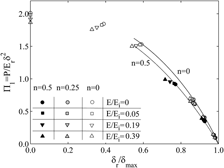Article contents
The reduced modulus in the analysis of sharp instrumented indentation tests
Published online by Cambridge University Press: 07 June 2012
Abstract

In the analysis of instrumented indentation data, it is common practice to incorporate the combined moduli of the indenter (Ei) and the specimen (E) in the so-called reduced modulus (Er) to account for indenter deformation. Although indenter systems with rigid or elastic tips are considered as equivalent if Er is the same, the validity of this practice has been questioned over the years. The present work uses systematic finite element simulations to examine the role of the elastic deformation of the indenter tip in instrumented indentation measurements and the validity of the concept of the reduced modulus in conical and pyramidal (Berkovich) indentations. It is found that the apical angle increases as a result of the indenter deformation, which influences in the analysis of the results. Based upon the inaccuracies introduced by the reduced modulus approximation in the analysis of the unloading segment of instrumented indentation applied load (P)–penetration depth (δ) curves, a detailed examination is then conducted on the role of indenter deformation upon the dimensionless functions describing the loading stages of such curves. Consequences of the present results in the extraction of the uniaxial stress–strain characteristics of the indented material through such dimensional analyses are finally illustrated. It is found that large overestimations in the assessment of the strain hardening behavior result by neglecting tip compliance. Guidelines are given in the paper to reduce such overestimations.
- Type
- Articles
- Information
- Copyright
- Copyright © Materials Research Society 2012
References
REFERENCES
- 10
- Cited by




